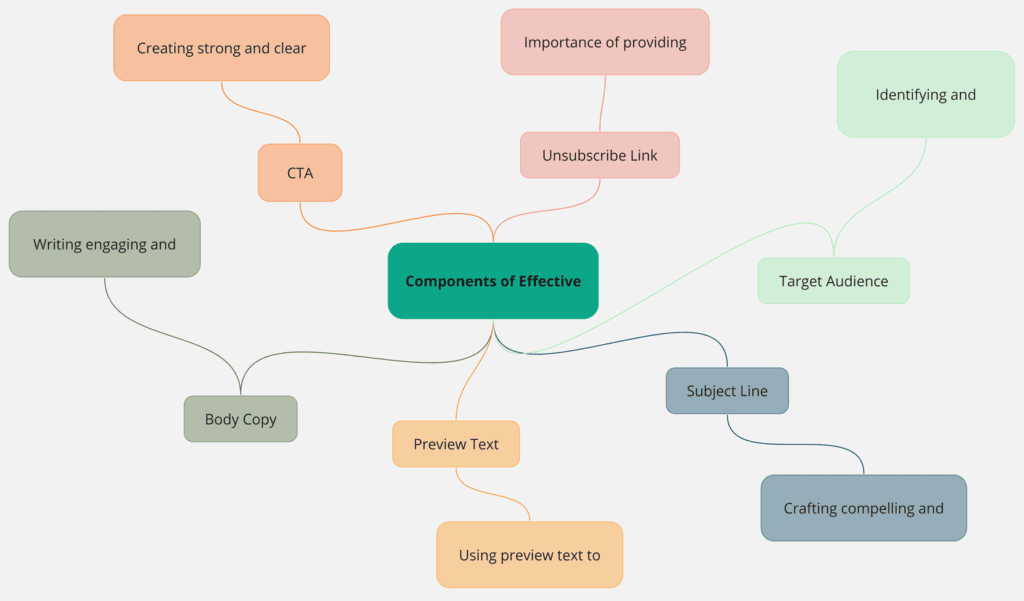Mastering Email Copywriting: A Comprehensive Guide

Email copywriting is a crucial aspect of any successful email marketing strategy. In today’s digital age, where inboxes are flooded with countless messages, crafting compelling and persuasive emails is more important than ever. Whether you’re promoting a product, sharing valuable content, or nurturing leads, the words you use in your emails can make all the difference in engaging your audience and driving them to take action.
In this comprehensive guide, we’ll explore the art and science of email copywriting. You’ll learn the essential components of effective email copy, proven techniques for crafting high-performing emails, and best practices for ensuring your messages stand out in crowded inboxes. By the end of this article, you’ll have the knowledge and tools you need to write emails that captivate your readers, boost your open rates, and ultimately achieve your marketing goals.
So, let’s start this exciting journey towards mastering the power of words in your email campaigns!
Understanding Email Copywriting
Before we delve into the intricacies of crafting compelling email copy, let’s first establish a solid foundation by understanding what email copywriting is and its primary purpose.
Definition and Purpose
Email copywriting is the art of writing persuasive and engaging content for email campaigns. It involves strategically crafting your email’s subject line, preview text, body copy, and call-to-action (CTA) to capture your audience’s attention, deliver value, and encourage them to take the desired action, such as making a purchase, signing up for a webinar, or downloading a resource.
The primary goals of email copywriting are to:
- Engage your subscribers and keep them interested in your content
- Build trust and establish a strong relationship with your audience
- Encourage readers to take specific actions that align with your marketing objectives
- Ultimately, drive conversions and revenue for your business
By understanding the essence of email copywriting and its objectives, you can approach your email campaigns with a clear focus and purpose, setting the stage for success.
Components of Effective Email Copywriting
To create emails that resonate with your audience and achieve your desired results, it’s essential to understand the key components that make up effective email copywriting. Let’s explore each element in detail.

Target Audience
A deep understanding of your target audience is the foundation of any successful email campaign. Before you start writing, take the time to research and develop a clear picture of your ideal reader. Consider their:
- Demographics (age, gender, location, etc.)
- Interests and preferences
- Pain points and challenges
- Desired outcomes and aspirations
By tailoring your email copy to your target audience’s specific needs and desires, you can create messages that truly resonate with them.
Subject Line
Your email’s subject line is the first thing recipients see in their inbox, and it plays a crucial role in determining whether they open your email or not. To craft compelling subject lines:
- Keep them concise and to the point (ideally under 60 characters)
- Use actionable and descriptive language that piques curiosity
- Personalize them with the recipient’s name or other relevant information
- Test different variations to see what works best for your audience
Preview Text
Preview text is the brief snippet of text that appears next to the subject line in most email clients. It provides an additional opportunity to entice readers to open your email. When writing preview text:
- Treat it as an extension of your subject line
- Use it to provide more context or highlight a key benefit
- Keep it concise (around 50-100 characters)
- Ensure it aligns with the content of your email
Body Copy
The body copy is the main content of your email, where you deliver your message and provide value to your readers. To write engaging body copy:
- Use a conversational and relatable tone
- Break up the text with short paragraphs, bullet points, and subheadings for easy readability
- Focus on benefits rather than just features
- Use storytelling and emotional appeals to connect with your audience
- Optimize for mobile devices by keeping the content concise and using a single-column layout
Call to Action (CTA)
Your CTA is the specific action you want your readers to take after reading your email. To create strong and effective CTAs:
- Use clear and action-oriented language (e.g., “Shop Now,” “Download Your Free Guide”)
- Make them visually prominent and easy to click
- Limit the number of CTAs in your email to avoid confusion
- Create a sense of urgency or scarcity to encourage immediate action
Unsubscribe Link
While it may seem counterintuitive, including an easy-to-find unsubscribe link in your emails is essential for building trust and complying with email marketing regulations. Make sure your unsubscribe link is:
- Clearly visible at the bottom of your email
- Easy to use and processes unsubscribe requests promptly
- In compliance with legal requirements, such as the CAN-SPAM Act
By understanding and optimizing these key components of email copywriting, you’ll be well on your way to creating emails that captivate your audience and drive results.
Crafting the Perfect Email
Now that we’ve covered the essential components of email copywriting, let’s explore how to combine them to craft the perfect email that resonates with your audience and achieves your marketing goals.
Setting Clear Goals
Before you start writing your email, defining the specific objective you want to achieve is crucial. Some common email marketing goals include:
- Driving sales or conversions
- Promoting a new product or service
- Educating your audience about a topic
- Nurturing leads and building relationships
- Encouraging engagement and feedback
Setting clear goals ensures that your email copy aligns with your overall marketing strategy and guides readers towards the desired action.
Maintaining Brand Voice
Consistency in your brand’s tone and style across all your emails is essential for building trust and recognition with your audience. To maintain a strong brand voice:
- Develop a set of brand guidelines that outline your company’s personality, values, and communication style
- Use a consistent tone that aligns with your brand’s identity (e.g., friendly, professional, informative)
- Incorporate your brand’s visual elements, such as logos, colours, and fonts, to create a cohesive look and feel
Using Active Language
Use active and dynamic language throughout your email copy to keep your readers engaged and motivated to take action. This means:
- Using action verbs and powerful phrases that inspire and motivate
- Writing in the present tense to create a sense of immediacy
- Avoiding passive voice and convoluted sentence structures
- Focusing on the benefits and outcomes your readers can achieve by taking action
Personalisation and Relevance
Personalizing your emails and making them relevant to your individual readers is key to capturing their attention and building a strong connection. To achieve this:
- Use merge tags to dynamically insert the recipient’s name, location, or other personal details
- Segment your email list based on demographics, interests, or past behaviour to send targeted content
- Tailor your message and offers to the specific needs and preferences of each segment
- Use behavioural triggers like abandoned cart emails or post-purchase follow-ups to deliver timely and relevant content.
By setting clear goals, maintaining a consistent brand voice, using active language, and personalizing your emails, you can craft messages that truly resonate with your audience and drive meaningful results.
Techniques for High-Performing Emails
Consider implementing these proven techniques to improve your email copywriting and create campaigns that consistently deliver outstanding results.
Power Words and Emotional Triggers
Using power words and emotional triggers in your email copy can significantly impact your readers’ engagement and motivation to take action. Power words are persuasive and compelling words that evoke strong emotions, such as:
- “Exclusive” – creates a sense of scarcity and exclusivity
- “Proven” – establishes credibility and trust
- “Guaranteed” – reduces risk and provides assurance
- “Instant” – promotes immediate gratification
Emotional triggers are words and phrases that tap into your readers’ deep-seated desires, fears, and aspirations, such as:
- “Unlock your potential” – appeals to personal growth and achievement
- “Limited time offer” – creates a fear of missing out (FOMO)
- “Join the community” – fosters a sense of belonging and connection
By strategically incorporating powerful words and emotional triggers into your email copy, you can create a more compelling and persuasive message that drives action.
Avoiding Spam Triggers
To ensure your emails reach your subscribers’ inboxes and avoid being flagged as spam, it’s essential to avoid common spam triggers in your email copy. Some words and phrases to steer clear of include:
- “Free” – overuse can trigger spam filters
- “Buy now” – can come across as aggressive and spammy
- “Click here” – feels generic and impersonal
- “!!!” – excessive use of exclamation points can be a red flag
Instead, focus on creating compelling and valuable content that naturally encourages readers to take action without relying on spammy tactics.
Check out Mail Tester to see if your email gets marked for spam.
Segmentation and Targeting
Segmenting your email list and sending targeted campaigns to specific groups of subscribers is a powerful way to increase the relevance and effectiveness of your emails. Some common ways to segment your list include:
- Demographics (age, gender, location, etc.)
- Interests and preferences
- Past purchase behaviour
- Engagement levels (e.g., active vs. inactive subscribers)
By sending targeted emails to specific segments, you can deliver more personalized and relevant content that resonates with your readers and drives higher engagement and conversion rates.
Split Testing and Experimentation
To continually improve your email copywriting and optimize your campaigns for success, it’s crucial to embrace split testing (also known as A/B testing) and experimentation. This involves creating two or more variations of your email and sending them to different list subsets to see which performs better. Elements you can test include:
- Subject lines
- Preview text
- Body copy
- Calls-to-action
- Images and layouts
Regularly testing and analyzing your results can gain valuable insights into what works best for your audience and make data-driven decisions to improve your email copywriting over time.
Incorporating these advanced techniques into your email copywriting strategy will help you create high-performing campaigns that consistently engage your audience and drive outstanding results.
Best Practices for Email Copywriting
To ensure your email copywriting is effective and aligns with industry standards, it’s important to follow these best practices:
- Keep your emails concise and to the point, focusing on delivering value to your readers.
- Use a clear and descriptive subject line that accurately reflects the content of your email.
- Personalize your emails with the recipient’s name and other relevant information to build a stronger connection.
- Write in a conversational and relatable tone, as if you’re speaking directly to the reader.
- Use short paragraphs, bullet points, and subheadings to make your content easy to scan and digest.
- Highlight your offer’s or message’s benefits rather than just listing features.
- Include a clear and prominent call-to-action (CTA) that guides readers towards the desired action.
- Optimize your emails for mobile devices, as many readers will view them on their smartphones.
- Test your emails across different email clients and devices to ensure they display correctly.
- Proofread your emails for spelling, grammar, and formatting errors before sending them.
Adhering to these best practices will help you create email copy that engages your audience, builds trust, and drives results.
Examples and Templates
To help you put your email copywriting knowledge into practice, let’s explore some examples of effective emails and templates you can use as a starting point for your own campaigns.
Examples of Effective Emails
- Airbnb’s personalized travel recommendations
- Subject line: “Discover the perfect getaway for your next adventure“
- Personalized content based on the user’s past booking history and preferences
- Stunning imagery and compelling descriptions of recommended destinations
- Clear CTA to book a stay or explore more options
- Grammarly’s weekly writing tips newsletter
- Subject line: “Improve your writing with these 5 simple tips“
- Valuable and actionable advice for improving writing skills
- Concise and easy-to-read format with bullet points and examples
- CTA to upgrade to Grammarly Premium for additional features
- Dropbox’s onboarding email series
- Subject line: “Welcome to Dropbox! Let’s get started“
- Step-by-step guide to setting up and using Dropbox
- Highlights key features and benefits of the platform
- CTAs to download the app, invite team members, and explore integrations
Ready-to-Use Templates
- Promotional email template
- Subject line: “[Exclusive Offer] Save X% on [Product/Service] – Limited Time Only!“
- Preview text: “Don’t miss out on this special deal, available only to our subscribers.“
- Body copy: Highlight the key benefits of the product/service and create a sense of urgency around the limited-time offer. Use bullet points to showcase features and customer testimonials for social proof.
- CTA: “Shop Now” or “Claim Your Discount“
- Abandoned cart email template
- Subject line: “You left something behind! Complete your purchase now.“
- Preview text: “Your [Product Name] is waiting for you. Finish your order today!“
- Body copy: Remind the reader of the items they left in their cart and showcase the benefits of completing their purchase. Offer a small incentive, such as free shipping or a discount code, to encourage them to take action.
- CTA: “Complete Your Purchase” or “Return to Cart“
By studying these examples and using the templates as a starting point, you can create compelling email copy that resonates with your audience and achieves your marketing goals.
Measuring Success
Tracking and analysing key performance metrics is essential for continually improving your email copywriting and optimizing your campaigns for better results. By measuring your success, you can identify what’s working well and where there’s room for improvement.
Key Metrics to Track
- Open rate: The percentage of recipients who opened your email. A high open rate indicates that your subject line and preview text effectively capture your audience’s attention.
- Click-through rate (CTR): The percentage of recipients who clicked on a link within your email. A high CTR suggests that your email copy and CTA are compelling and relevant to your audience.
- Conversion rate: The percentage of recipients who completed a desired action, such as making a purchase or filling out a form, after clicking through from your email. This metric measures the overall effectiveness of your email campaign in driving your marketing goals.
- Bounce rate: The percentage of emails that couldn’t be delivered to recipients’ inboxes. A high bounce rate may indicate issues with your email list quality or deliverability.
- Unsubscribe rate: The percentage of recipients who opted out of receiving future emails from your brand. A high unsubscribe rate may suggest that your email content is not meeting your audience’s expectations or preferences.
Analyzing and Optimizing
Once you’ve tracked your key performance metrics, it’s time to analyze your results and identify opportunities for optimization. Some strategies for improving your email copywriting based on your data include:
- A/B testing subject lines and preview text to improve open rates
- Experimenting with different CTA copy and placement to boost click-through rates
- Segmenting your email list and personalizing your content to increase conversion rates
- Regularly cleaning your email list and using double opt-in to reduce bounce rates
- Surveying your audience and adjusting your email content to meet their needs and preferences better, reducing unsubscribe rates
By consistently measuring your success and making data-driven optimizations, you can continuously improve your email copywriting and achieve better results over time.
Common Challenges and Solutions
Even the most experienced email copywriters face challenges from time to time. Here are some common issues you may encounter and strategies for overcoming them.
Dealing with Low Engagement
If you’re struggling with low open rates, click-through rates, or conversion rates, try these strategies to boost engagement:
- Segment your email list and tailor your content to each group’s specific interests and needs
- Experiment with different subject lines, preview text, and email formats to see what resonates best with your audience
- Provide valuable and relevant content that addresses your readers’ pain points and desires
- Use personalization and dynamic content to create a more targeted and engaging experience
Overcoming Writer’s Block
When you’re feeling stuck and struggling to find the right words for your email copy, try these tips to get your creative juices flowing:
- Review your brand guidelines and messaging to ensure your copy aligns with your overall brand voice and tone
- Research your target audience and create buyer personas better to understand their needs, preferences, and language
- Study examples of successful email campaigns in your industry for inspiration and ideas
- Use writing prompts or templates to provide a starting point and structure for your copy
- Take breaks and step away from your writing to refresh your mind and come back with a new perspective
By proactively addressing these common challenges and implementing these solutions, you can overcome obstacles and consistently create effective email copy that engages your audience and drives results.
Case Studies
To illustrate the effectiveness of well-crafted email copywriting, let’s take a look at some real-life case studies from successful brands.
Airbnb’s Personalized Travel Recommendations
- Campaign Objective: Increase user engagement and bookings.
- Details:
- Subject Line: “Discover the perfect getaway for your next adventure“
- Personalization: Custom travel suggestions tailored to users’ interests and past trips.
- Visuals: Stunning imagery of recommended destinations.
- CTA: Clear and prominent, directing users to book a stay or explore more options.
- Results: This campaign significantly increased user engagement and conversion rates by leveraging personalization and high-quality visuals.
Grammarly’s Weekly Writing Tips Newsletter
- Campaign Objective: Educate users and promote premium features.
- Details:
- Subject Line: “Improve your writing with these 5 simple tips“
- Content: Valuable, actionable advice in a concise, easy-to-read format.
- CTA: Encouraged users to upgrade to Grammarly Premium for additional features.
- Results: This campaign improved user engagement and successfully converted free users to premium subscribers by providing consistent value.
Dropbox’s Onboarding Email Series
- Campaign Objective: Help new users get started with Dropbox.
- Details:
- Subject Line: “Welcome to Dropbox! Let’s get started“
- Content: Step-by-step guides for setting up and using Dropbox.
- Highlight: Key features and benefits.
- CTAs: Encouraged actions like downloading the app and inviting team members.
- Results: This campaign effectively guided new users through the initial setup, increasing user activation and long-term retention.
Industry-Specific Insights
While the principles of effective email copywriting remain consistent across industries, it’s essential to tailor your strategies to your specific niche. Here are some insights and best practices for common industries:
E-commerce
- Email Campaigns: Promotional offers, abandoned cart reminders, and product recommendations.
- Best Practices: Use clear and enticing subject lines, personalized product recommendations based on browsing and purchase history, and include strong, actionable CTAs.
- Example: “Your favourite items are waiting for you – complete your purchase now!“
B2B (Business-to-Business)
- Email Campaigns: Lead nurturing, product updates, case studies.
- Best Practices: Focus on building relationships and trust, provide value through informative content, and use case studies to demonstrate success.
- Example: “How [Company] achieved a 30% increase in productivity with our solution.“
SaaS (Software as a Service)
- Email Campaigns: Onboarding, feature announcements, user engagement.
- Best Practices: Offer step-by-step guides for new users, highlight new features, and engage users with tips and best practices.
- Example: “Welcome to [Software]! Let’s get you set up.“
Nonprofits
- Email Campaigns: Fundraising appeals, impact reports, event invitations.
- Best Practices: Use storytelling to convey impact, personalize appeals to donors, and provide clear, actionable donation CTAs.
- Example: “See the difference your support makes – donate today to help us reach more people.“
Expanded FAQ
- Q: How can I make my email copy more engaging?
A: To make your email copy more engaging, use storytelling, evoke emotions, and focus on the benefits for your readers. Use a conversational tone and address your readers directly to create a stronger connection. - Q: Should I use images in my emails?
A: Yes, using relevant, high-quality images can make your emails more visually appealing and engaging. However, ensure that your email still conveys the main message and CTA even if the recipient’s email client blocks images. - Q: How can I avoid my emails being marked as spam?
A: To avoid spam filters, obtain explicit permission from your subscribers, use a reputable email service provider, keep your email list clean, and avoid using spam trigger words excessively. Also, include an easy-to-find unsubscribe link in every email. - Q: How long should my emails be?
A: The ideal email length depends on your purpose and audience. Generally, aim to keep your emails concise and focused on delivering value. If you have a lot of content, consider breaking it up into multiple emails or linking to a blog post or landing page. - Q: How can I improve my email click-through rates?
A: To improve click-through rates, make sure your CTA is clear, prominent, and relevant to your email content. Use action-oriented language and create a sense of urgency. Place your CTA in a visible location and consider using a button to make it stand out.
Printable Checklist
We’ve created a printable checklist to help you implement the strategies and best practices covered in this guide. Use it to ensure you’re covering all the essential elements of effective email copywriting.
- Define your target audience and their preferences
- Set clear goals for your email campaign
- Craft a compelling subject line
- Write engaging preview text
- Use a conversational and relatable tone in your body copy
- Focus on benefits and use storytelling to connect with readers
- Include a clear and prominent call-to-action (CTA)
- Personalize your email content
- Optimize for mobile devices
- Test your email across different clients and devices
- Proofread for spelling, grammar, and formatting errors
- Include an easy-to-find unsubscribe link
- Monitor key performance metrics and analyze results
- Continuously test and optimize your email copywriting
- Implement segmentation and targeting strategies
By following this checklist and implementing the insights from this comprehensive guide, you’ll be well on your way to creating email copy that engages your audience, drives action, and achieves your marketing goals.
In The End, It Doesn’t Even Matter (*but in this case, it absolutely does)
Congratulations on making it to the end of this comprehensive guide on email copywriting! By now, you should understand the key components, techniques, and best practices for crafting compelling and effective email copy.
Remember, the key to success in email copywriting is to always keep your audience in mind. Focus on delivering value, building relationships, and driving meaningful actions that align with your marketing goals.
As you implement the strategies and tips covered in this guide, don’t be afraid to experiment, test, and iterate based on your results. Continuously measure your performance, learn from your successes and failures, and strive to improve your email copywriting skills over time.
By mastering the art and science of email copywriting, you’ll be well-equipped to create campaigns that stand out in crowded inboxes, engage your subscribers, and ultimately drive the results your business needs to thrive.
So, start putting these insights into practice today, and watch your email marketing success soar to new heights!


